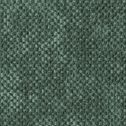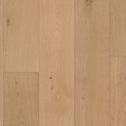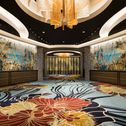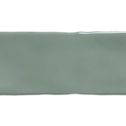Trend: Biophilic Design
About the Trend: Biophilic Design
Biophilic design embodies the essence of connecting our living spaces with the natural world, a concept that's gaining momentum as we seek sanctuary in our homes.
This design philosophy integrates natural elements like lush plants, the use of materials that evoke the outdoors, and abundant natural lighting to craft spaces that are not just visually appealing but are nurturing and restorative. It taps into the innate human inclination to affiliate with nature, aiming to create environments that enhance well-being and tranquility.
Biophilic Colour Considerations
When considering colours for achieving a biophilic design trend in your space, it's essential to draw inspiration from nature's palette to create a restorative and harmonious environment. Here are some colour considerations to keep in mind:
Earthy Greens
Mimic the lushness of vegetation and foliage by incorporating various shades of green. From the soft, muted tones of sage to the vibrant hues of emerald, green brings a sense of vitality and freshness to any space, echoing the outdoors.
Rich Browns and Neutrals
Emulate the earth's foundation with browns, beiges, and other neutral tones. These colours provide a warm, grounding effect, making them excellent for floors, walls, and large furniture pieces. They serve as a solid base that allows other nature-inspired elements to stand out.
Sky Blues
Incorporate light to medium blues to reflect the sky and water, adding a calming and serene vibe to your environment. Blue tones can cool down a space and are perfect for creating a tranquil retreat.
Wood and Stone Hues
To further the connection with nature, integrate colours that mimic natural materials like wood and stone. These textures and tones can make a space feel more organic and connected to the natural world.
Styling Considerations
To truly embrace the biophilic design trend, styling considerations play a crucial role. This approach goes beyond mere aesthetics to foster a connection between your living environment and the natural world.
Incorporate Natural Elements
Begin by integrating natural materials such as wood, stone, bamboo, and rattan. These materials can be included in furniture, decorative items, or architectural elements like wooden beams or stone countertops. The tactile nature of these materials enhances the sensory experience of the space.
Use of Plants
Plants are a cornerstone of biophilic design, bringing life, colour, and freshness into any room. Consider a mix of large leafy plants, hanging plants, and small succulents to create layers of greenery. Vertical gardens or living walls are also a striking way to incorporate vegetation in a space-saving manner.
Maximise Natural Light
Allow as much natural light as possible to permeate the space. Use sheer curtains or blinds to diffuse light without completely blocking it. Skylights or larger windows can also dramatically increase the presence of natural light, enhancing mood and wellbeing.
Choose Nature-Inspired Patterns and Artwork
Wallpapers, textiles, and art that reflect natural scenes or patterns can add a subtle biophilic touch. Opt for designs inspired by leaves, flowers, landscapes, or abstract natural forms to reinforce the connection to nature.
Focus on Natural Colours
As previously discussed, your colour palette should reflect nature. However, when it comes to styling, think about how these colours can be layered and contrasted in accessories like cushions, rugs, and throws to mimic the diversity found in natural environments.
Prioritise Comfort and Wellbeing
Biophilic design is not just about how a space looks but how it feels. Ensure furniture is comfortable and arranged in a way that promotes relaxation and social interaction. Consider ergonomics and the flow of the space to create an environment that supports both physical and mental health.
Create your Harmonious Space
By thoughtfully incorporating these styling and colour considerations, you can create a space that not only embodies the beauty of the natural world but also promotes a deeper sense of wellbeing and connection to the environment. Biophilic design acknowledges that our surroundings profoundly affect our health, productivity, and overall happiness, making it a holistic approach to interior design.









